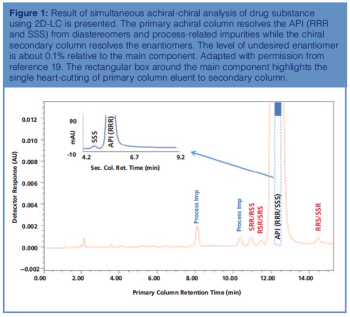Articles by C.J. Venkatramani

The evolution of two-dimensional liquid chromatography (2D-LC) instruments along with improved software capabilities has transferred 2D-LC from the hands of experienced researchers to functioning analytical laboratories in the pharmaceutical industry. 2D-LC offers chromatographers novel solutions to problems ranging from analyzing complex samples requiring excessively large peak capacities to separating simple compounds that are difficult to resolve. Recent developments in 2D-LC and 2D-LC–MS have demonstrated the potential of this technique in practice and 2D-LC is set to become an essential tool in the pharmaceutical sector to address problems ranging from coelution, peak purity assessment, simultaneous achiral-chiral analysis, genotoxic impurities, and more.

Is that peak “pure”? How do I know if there might be something hiding under there?

Is that peak “pure”? How do I know if there might be something hiding under there?

Here, we see how 2D-LC can solve coelution problems that are difficult or impossible to address using peak purity tools or curve resolution methods.

In part II of this series, we explore how curve resolution methods advance purity assessments and illustrate one of the most popular techniques, which adds a powerful tool to the chromatographer’s arsenal.

Is that peak “pure”? How do I know if there might be something hiding under there?

Is that peak “pure”? How do I know if there might be something hiding under there?

Is that peak “pure”? How do I know if there might be something hiding under there? In part I of this series, we explore some of the concepts behind peak purity assessments, describe some tools that are used in commercially available software for these assessments,









